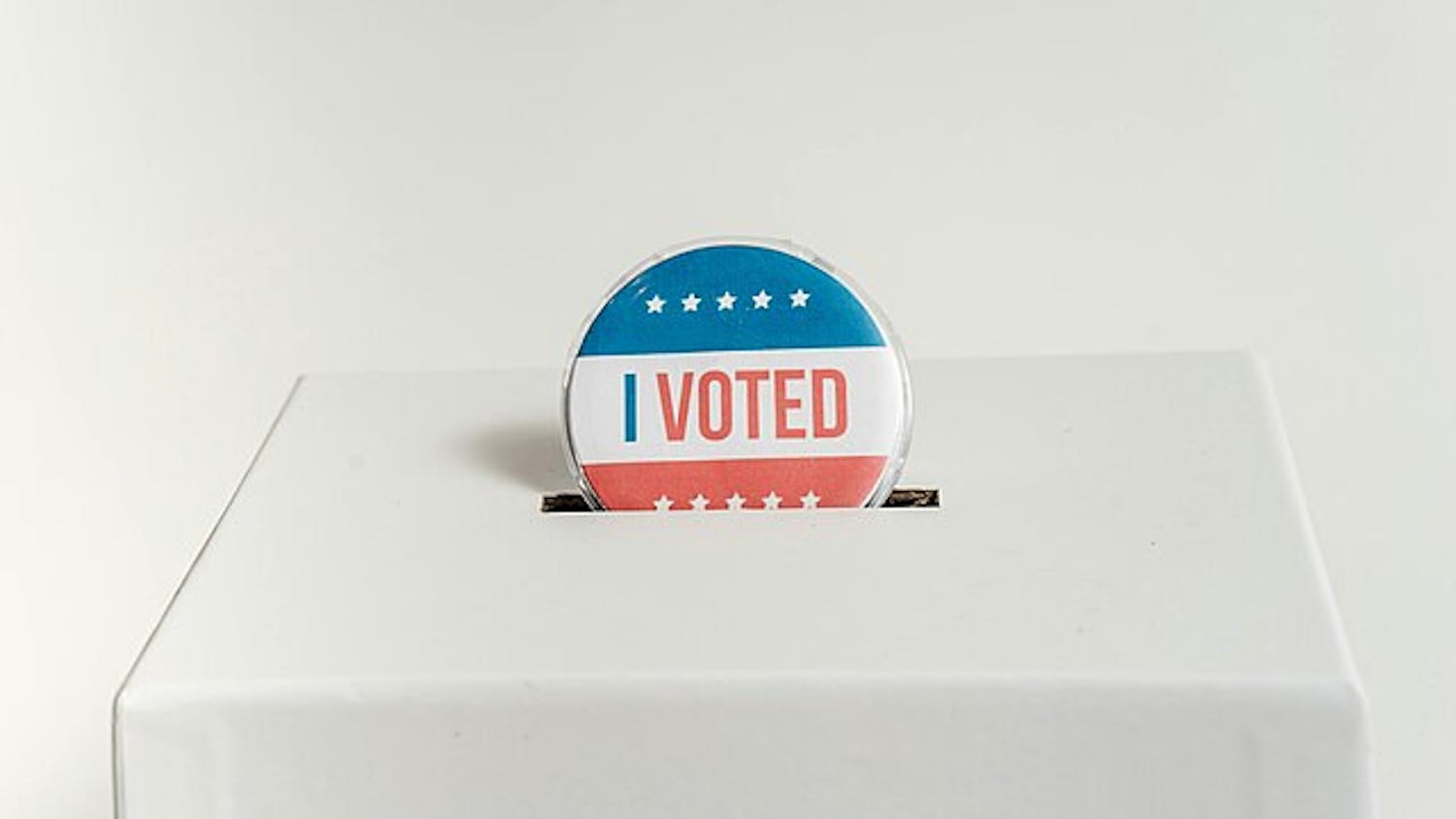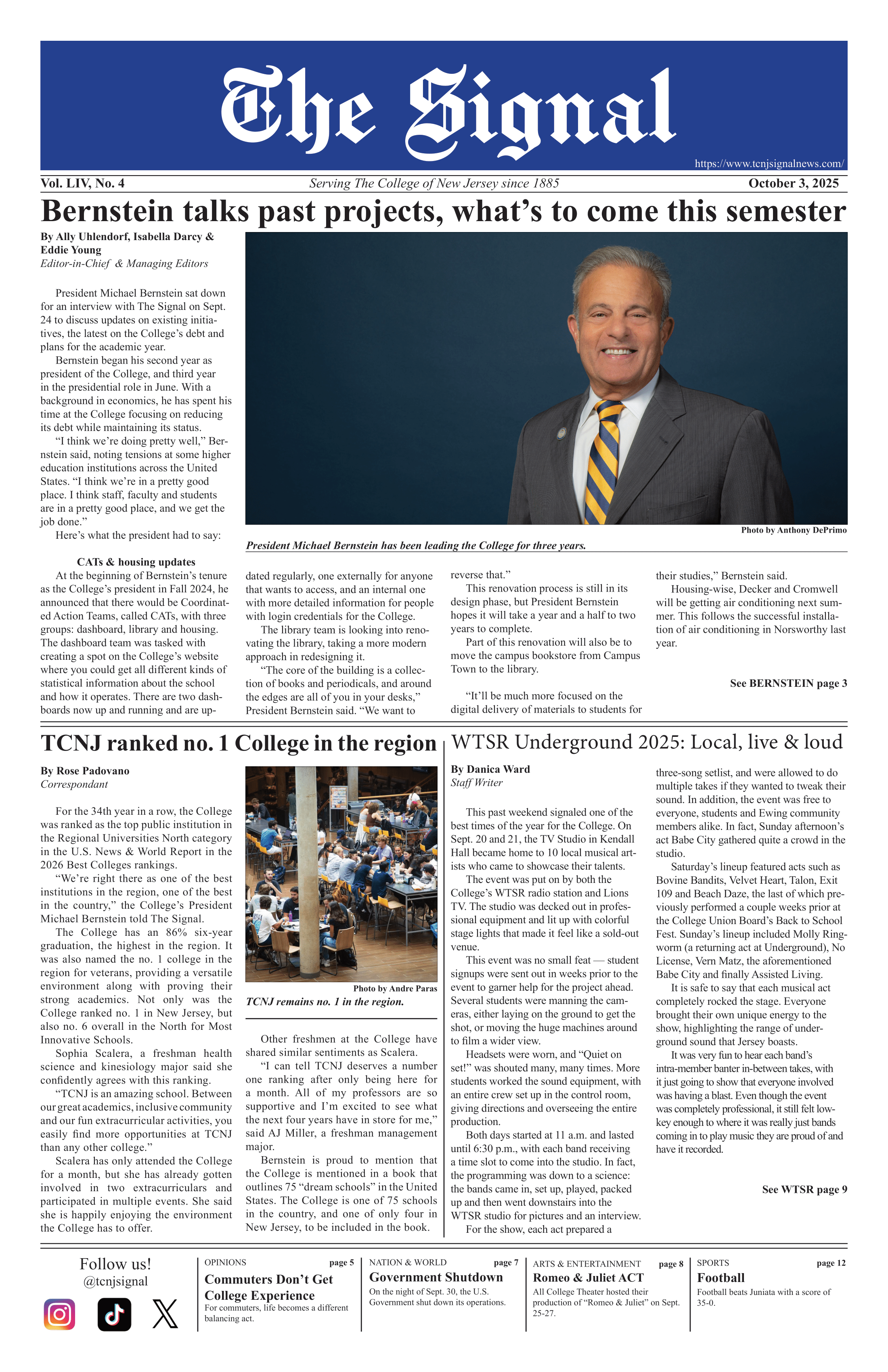The second floor of the Roscoe L. West Library looks nothing like the first. Where the ground level is stocked with copiers and computers, students on cell phones and shelves of bestsellers, the upper level could have been built in the 1930s along with Green Hall. Its green- and brown-tiled corridors lead to heavy wooden doors with golden room numbers etched onto them.
Room 214 is tucked into a distant corner. One would expect to see "Private Eye" embossed on its opaque window. But when the library archivist unlocks the door with a modern key, his first task is to turn off the alarm system. For this hidden room guards some of the most precious volumes of campus history - complete issues of The Signal since its first press run in 1885.
Red and blue bindings - ranging in size from magazine to broadsheet newspaper - fill an entire bookshelf. Their spines tell of issue dates and volume numbers, starting with Volume I, Issue I. Currently, The Signal boasts volume number CCXXII, which translates to 122. Some editors may have miscounted along the way (who is fluent in Roman numerals nowadays anyway?), because 2005 will mark the 120th anniversary of the publication. But the editors of the very first issue -December 1885 - could only start with I.
Little did they know that their scholarly literary magazine would take the form of a quarterly and a monthly before being suspended, only to be revived as a bi-weekly broadsheet before ultimately transforming into a weekly tabloid. Editors of the 1885 issue might roll in their graves if they saw the current one; but the publication has changed with the times, as the role of any newspaper is to keep up with them.
This, then, is a history of The Signal, The State Signal - "our Signal," as its original editors referred to it in their very first editorial in December 1885.
"Our Signal"
"It was a pretentious sheet from the first." That is how the editors of the December 13, 1929 broadsheet issue of The Signal described the original version - a literary magazine divided into "editorials" and "contributions."
Its role was to be the "official organ of the State Schools." At the time, the College was divided into two schools: the Model School (a prep school) and the Normal School (the College). The Signal was published by the Model School, which prepared students (predominantly male) for college and harbored a number of great literary societies. Hence, The Signal published essays more so than news.
All seven editors were men, with Frank B. Lee serving on the top rung as managing editor. In their first editorial, they acknowledged that their endeavor would be "our SIGNAL in the interests of the students of the Model and Normal Schools."
The editors maintained a scholarly, professional magazine with essays that flaunted a fantastic command of the English language. Take, for example, a January 1886 editorial on hazing:
"Ninety-nine men out of every hundred who enter schools or colleges respect the position taken by their fellows and pass through their course without molesting or maltreating their scholastic friends. By so doing they evince those gentlemanly instincts which are the results of good breeding. But the one man of the hundred ... is not fit to be in the society of high-minded, studious men. The school is no place for the hazer, he is better suited for the prize-ring."
Pieces like this support the 1929 Signal editors' accusation of the literary magazine being pretentious. But other local publications of the late 1880s had only praise for the new magazine. In a section titled "Kind words from our friends," Signal editors received praise from The Trenton Times and New York World:
"It is an admirable school paper in every respect. We wish it a large measure of success," The Trenton Times said.
New York World said, "There are seven editors and a whole school of reporters, so it ought to be a success."
Its advertisers also praised the magazine. They purchased pages of ads for their products - neckties, suits, hats and haircuts - in traditional late 19th century typeset. By March 1886, The Signal was on sale at all New Jersey State Schools, Brearley & Stoll's department store, Union News Company and The Pennsylvania Railroad at ten cents per copy.
Into the 20th century
By 1887, The Signal had a circulation of about 700 and became a quarterly magazine in 1889. It took on a new masthead with an illustration of an important campus building and ran a sole literary essay on the front page.
In 1894, The Signal once again became a monthly, and would remain that way until its mysterious suspension in 1918.
During that 24-year time period, however, The Signal took on a more feminine tone. Women's names started appearing in the staff box. For its 25th anniversary edition, Mary, Margaret, Jane, Anna, Elanor and Edith were in charge of the publication. On its front page was an essay on someone's summer experience at a girls' camp, and inside, the editors ran "compositions from the fourth and seventh graders."
The change is possibly attributed to The Signal passing into the hands of the Normal School, or the teacher's college, rather than the Model School. There is no exact takeover date for this, but the change in content clearly signals a change in publishers.
In 1918, however, The Signal went on an 11-year hiatus. The most likely reason was a lack of funds, even though the 25th anniversary issue was full of ads.
During this time, attempts were made to keep The Signal alive. Scattered between the official bound volumes in the library are independent issues of The Signal. One, from 1919, is a thin magazine with a pale green cover, adorned with the flag and the state seal of New Jersey. Its content focused on student organizations and campus happenings.
Such attempts, however, were futile and The Signal was lost until December 1929.
"Signal's On!"
On the shelves of the library archives, bound volumes of The Signal take on noticeable changes in 1929. Their bindings are blue, not red, and the issue size grows from that of a literary magazine to that of a broadsheet newspaper.
With the advent of the Student Activity Fee in Fall 1929, The Signal was able to start publishing again - this time as a bi-weekly, broadsheet newspaper.
Since the editors of the December 13, 1929 issue did not want to model their publication after the original "pretentious sheet," they decided to focus their content on school news, editorials and sports. Their Signal would be "typical of the progressive spirit so apparent today in our student body."
This was no jab at the original editors of The Signal; the first editorial praises the first Signal as having the largest circulation of any college publication in the East in 1890 and praises the original editors for setting a worthy goal for the new staff.
With much text, heads, and subheads, the new Signal looked like The New York Times, without pictures.
For the first time, its staff had an Editor in chief, who commanded news, art, social and assistant editors. A staff of reporters and typists was also acknowledged in the staff box.
The paper would keep this format for the next 30 years or so, making only one major editorial change: its name. In May 1930, it became The State Signal - a name that more accurately reflected its role as a medium for New Jersey schools. At this time, Liberty and Prosperity also made an appearance on the flag - another testament to the publication's role as a state medium.
Centennial Celebration
The headline jumped off the top of the page in a bold Times font: "Trenton begins one hundredth year with record freshmen enrollment." It was September 15, 1954, and it was the beginning of Trenton State College's centennial celebration.
Through May 1956, The Signal covered the College's anniversary extensively. October 9, 1955 marked a special centennial issue. Four editions of The Signal ran, each encompassing 25 years of College history. Each edition was written in the present tense.
For the 1855-1880 edition, the lead headline was "Cornerstone laid for New Jersey's first state normal school by Gov. Rodman M. Price."
The 1930-1955 edition commemorated The Signal's 50th anniversary, announcing that archival issues of The Signal from the library's collection would be on display for all to view.
Throughout this time, the staff remained predominantly female and maintained a bi-weekly circulation. It kept its text-heavy New York Times layout, but photographs were more abundant than they were in the early 1930s issues, especially in the sports section. This would lay the grounds for the next major change in publication: becoming a weekly.
The Signal goes weekly
In the present office of The Signal, the editors keep a well-preserved copy of the April 9, 1965 State Signal. The typeset still looks as if it was carefully placed on an ancient press, and the actual paper was thicker, heavier and brighter.
Today's editors think of how much easier the editors of the 1960s had it. They only had to produce six pages of newsprint per week. However, they did not have Macintosh, Adobe InDesign or the Internet to make their production nights quicker and easier.
Editors of the 1960s, in fact, had a lot to worry about. The times were changing. Their paper was taking on an even more progressive stance. The lead story for the April 9, 1965 issue was about a symposium on evolution and what problems teachers may encounter while trying to teach it.
The demographic of the College's readers was changing too. State schools began to become more separate from each other. By 1972, the name "State Signal" was retired and became, once again, simply The Signal.
The Signal of the 1970s was clearly no longer a typeset publication. Editors experimented with new means of printing and formatting. Most noticeably, it became a tabloid. The newsprint also became thinner - the kind that yellows in time - and articles reached beyond campus events.
It had an apparent liberal lean (the November 1, 1972 editorial headline was "the vote against Nixon") and more attention to national events. Its flag appeared in the center of the page, directly above the fold, which was common for tabloids in the 1970s.
Through the end of the decade, The Signal increased in size almost every year, maintaining a 24-page issue well into the 1980s. Those pages included progressive issues, such as birth control and a sexual health column.
It wasn't until the 1990s that the paper was subdivided into sections, including News, Opinions, Features and Sports. Editors then also dabbled in color printing but stuck mainly with black and white.
Volume CCXXII
Traces of the 1990s Signal can be detected in today's volume. Today's Signal is still a weekly tabloid broken into sections - News, Opinions, Features, Entertainment and Sports. The flag is modernized, and each issue is printed in color.
About 20 students work on staff - 16 in the editorial department and four in the business office. It is funded entirely through ad revenue; gone are the days of assistance from the Student Activities Fund. That disappeared just as the "neckties, suits, hats and haircuts" advertisers did.
Some qualities of the 1885 version still stand. The Signal is still a recognized publication within the state. It was named the First Place winner of the General Excellence category in the New Jersey Press Association's "Better College Newspaper Contest" in 1997, 2001 and 2003.
It is still "our SIGNAL in the interests of the students" of The College of New Jersey.
And like the editors of the December 13, 1929 issue of the new, bi-weekly Signal said, "Its form has changed many times, but it has always been 'The Signal.'"






